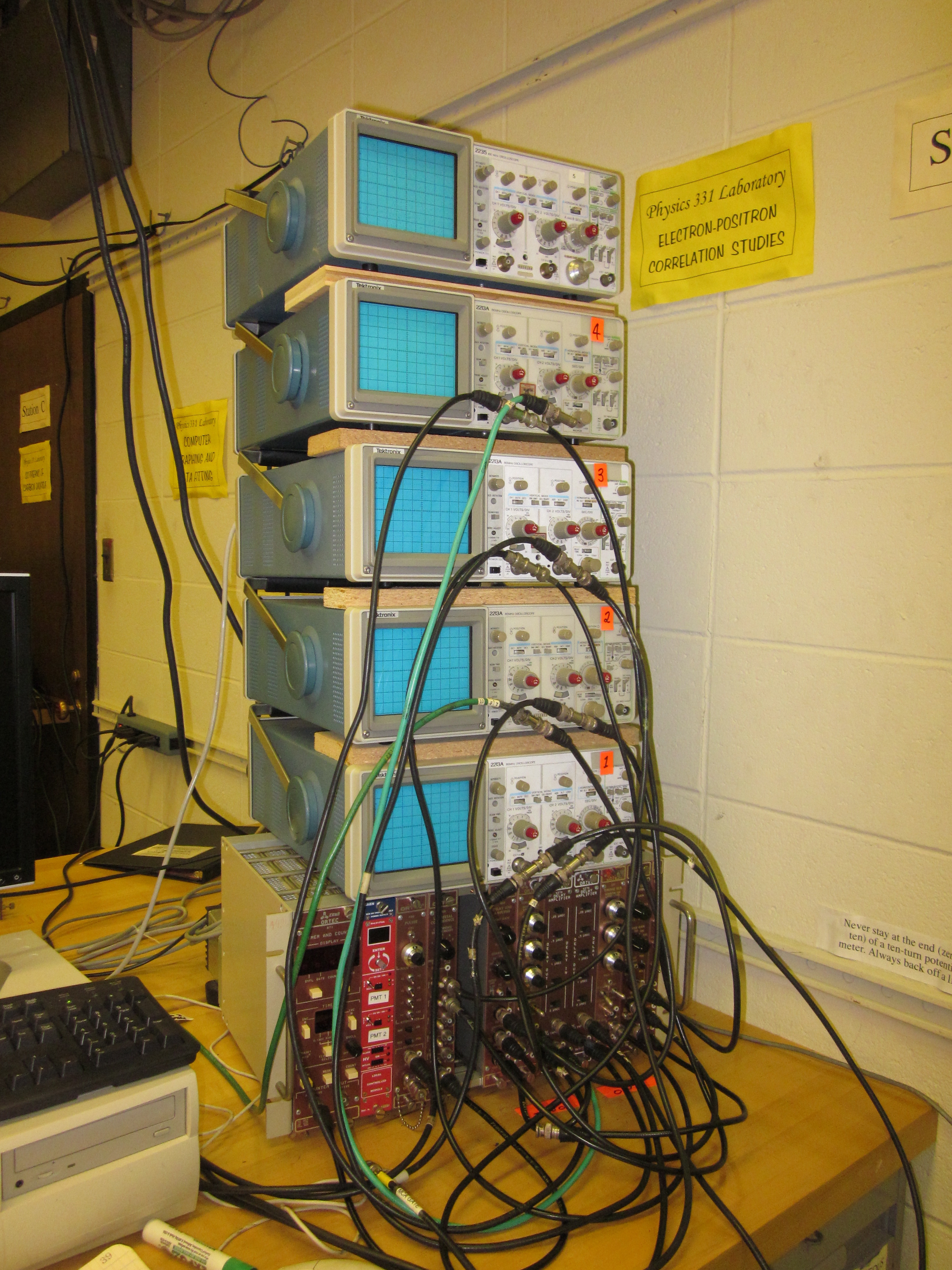I worked on the electron positron annihilation experiment. I used two µ-Ci 22-Na sources and I measured the angle correspondence between the gamma rays as well as the amount of rays emitted every ten seconds by the sources.
When an electron collides with a positron they annihilate each other, and produce two gamma rays that travel in opposite directions because of momentum conservation. For this reason the two gamma rays are produced 180 degrees apart.
I had two identical setups, with two detectors placed at an equal distance from the source. The gamma ray incident on the detector hit a NaI crystal and liberated photoelectrons which were multiplied into a large pulse of electrons. The pulse traveled to a preamplifier (Ortec Model 113) where an equivalent pulse was sent to a Delay Line Amplifier (DLA, Ortec Model 460). The DLA took the pulse, amplified it and shaped it before sending it to the Multi Channel Analyzer (MCA) which measured the height of the pulse and counted the number of pulses with a certain height. The number of photoelectrons was proportional to the energy of the gamma ray, and as a result so was the height of the pulse.
The MCA produced a histogram of the number of events vs channel number. Every channel number had a pulse height, an energy value associated to it, so we could identify the peak that occurred at 511 keV. This peak came from the gamma rays caused by the positron electron annihilation. All the other peaks and bumps that showed up were background radiation. We set up a time delay with a Timing Single Channel Analyzer (TSCA) so that both experimental setups were aligned. This would help us ensure that two gamma rays detected during the same time interval by different detectors came from the same annihilation event.
In order to make sure both pulses that were created simultaneously arrived at the same time we used a test pulse. We then eliminated the background pulses by adjusting the windows of the TSCA. To get both pulses to coincide we looked for coincidence counts. If there were none, then we knew that something was wrong. We changed the delay time on one of the TSCA’s and found that if it wasn’t within the interval 3.5 and 5.58 microseconds the coincidence decreased rapidly to zero.

Coincidence counts as a function of the delay time between both systems. Note that we can only find counts within the interval 3.5 – 5.58 µs. The resolving time 2τ is equal to the width of the interval, 2.08 µs.
We got rid of the test pulse and measured the coincidence counts every ten seconds of the gammas from the source. We were able to find the real activity of the source, taking into account the efficiency of the detectors and the chance coincidence counts (ie not true coincidences.) I calculated the real activity was 1.8 +- 0.4x 10^6 counts per second (which for some reason took waaaaaay too long, and might be due to the fact that simple algebra is really hard on Fridays.)
Finally I calculated the angle correlation between the pairs of gamma rays. I changed the angle between the detectors and found that as expected the coincidence count had a max at 180 degrees, but it was surprising that it took awhile to go all the way to zero. In fact it wasn’t until a 40 or more degree angle from the original 180 degrees. This was probably due to the fact that the detectors and the delay time were too big, and that the detectors were closely spaced together so the difference between angles wasn’t detected accurately. In fact, the width of the Gaussian I fit to the data was caused by the angular resolution of the apparatus, that is the spread of angles the detectors detected at once. This width turned out to be 6.94 plus or minus 0.18, therefore the angular resolution of the apparatus was 7 degrees. The peak located at 181.21 instead of 180 can be explained as a result of uncertainty in the angle measurement. In conclusion, the gamma decay of sodium-22 gives us a great way to align experimental set ups as well as a way to measure their angular resolution.



